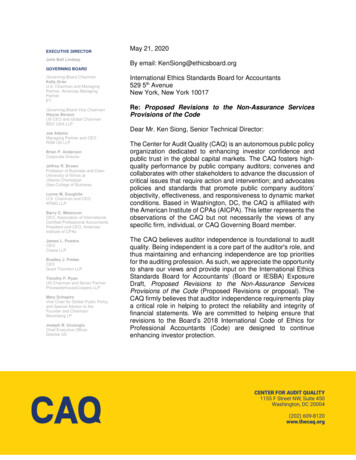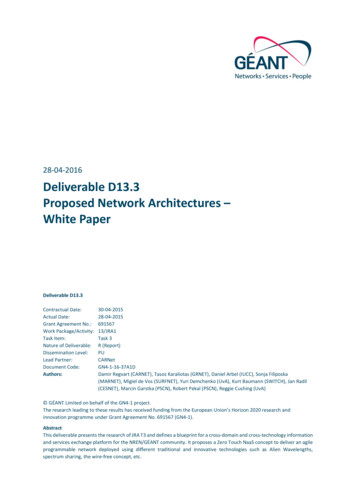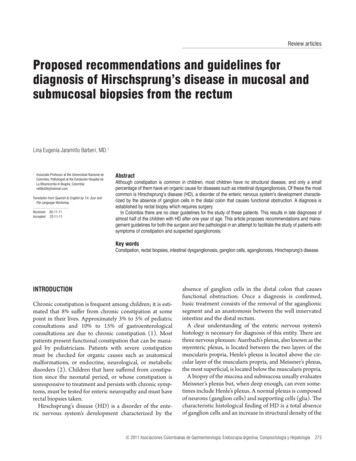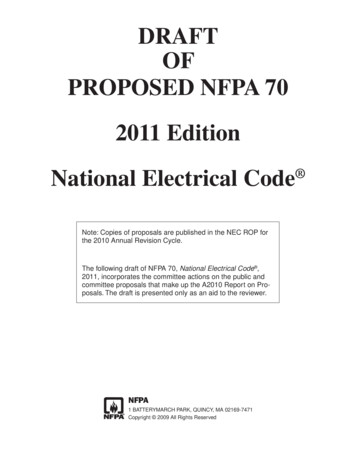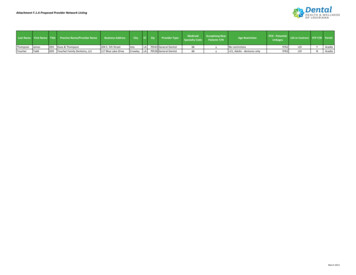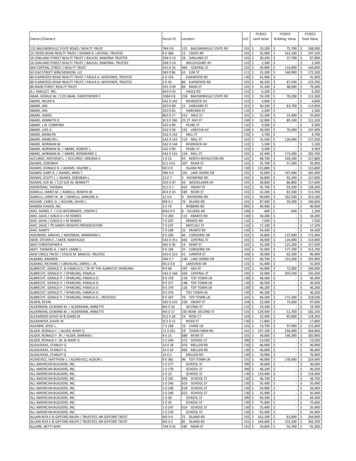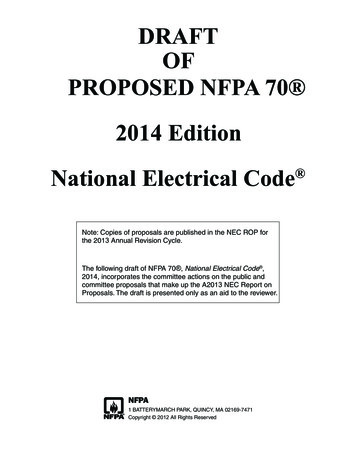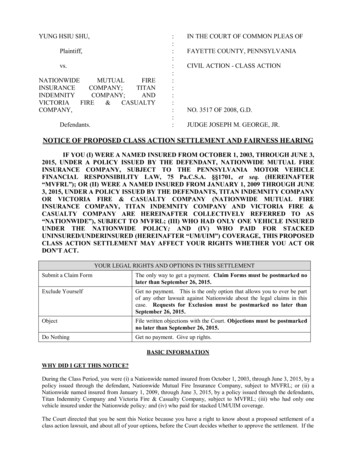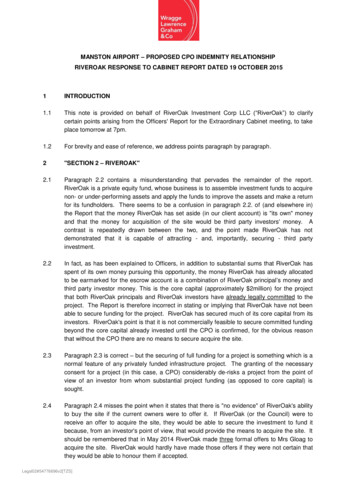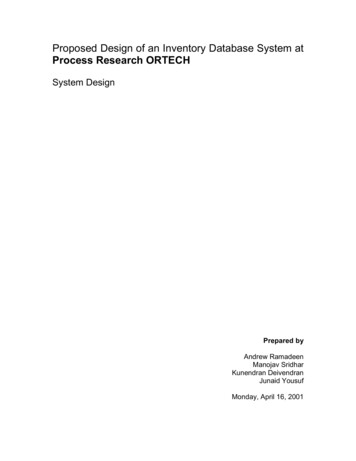
Transcription
Proposed Design of an Inventory Database System atProcess Research ORTECHSystem DesignPrepared byAndrew RamadeenManojav SridharKunendran DeivendranJunaid YousufMonday, April 16, 2001
Introduction. 5Identifying the Problem. 5Requirements . 6Functional Requirements .6Nonfunctional Requirements .7Design Phase . 81.Global System Architecture.8Hardware. 8Networking . 9Software Platform . 9Hardware. 10Network – LAN. 10Software – MS Windows and MS Applications. 102.Diagrammatic Modeling.11State Diagrams . 12Activity Diagrams . 13E-R Diagram . 143.Software Architecture.16Three-Tier Design . 16Repository-Based Design . 164.5.Database Design.17User Interface Design .20Conclusions . 22Appendix 1 . 24Brainstorming Session 1 – March 27th 2001.24Appendix 2 . 25Explanation of Appendices – March 27th 2001 .25Appendix 3 . 26Organizational Chart – March 27th 2001.26Appendix 4 . 27PRO Inventory System Flow Chart – March 27th 2001.27Appendix 5 . 29Functional Requirements – March 27th 2001.29I.II.III.IV.Details of data storage . 31Details of output . 31Details of input. 32Details of Information Processing . 32Appendix 6 . 33Non-functional Requirements – March 27th 2001 .331.2.3.4.5.6.7.Software Requirements. 34Hardware Requirements . 34Security Requirements. 34Reliability/Survivability Requirements . 34Interface Requirements. 35Lifecycle Requirements. 35Economic Requirements . 35Appendix 7 . 362
Brainstorming Session 2 – March 29th 2001.36Appendix 8 . 37Information Gathering Summary – March 30th 2001.37Appendix 9 . 38Current Computing Capabilities – March 30th 2001.381.2.3.4.Server Computer - (Glass box) . 38Client Computer(s) - (Glass box) . 38Networking Components. 39Software Licenses . 39Appendix 10 . 41Hardware Considerations – April 1st 2001 .41Appendix 11 . 43Network Considerations – April 1st 2001 .43Appendix 12 . 44Software Platform Considerations – April 1st 2001 .44Appendix 13 . 45Global System Architecture Conclusions – April 3rd 2001 .45Hardware. 45Network – LAN. 45Software – MS Windows and MS Applications. 45Appendix 14 . 46Explanation of Diagrams – April 5th 2001 .46Appendix 15 . 47Class Diagram for Inventory System – April 5th 2001 .47Class Staff Member . 47Class Office Staff . 47Class Technical Staff . 47Class Upper Management . 48Class Reports . 48Class Order Table. 48Class Order. 48Class Inventory . 48Class Inventory Item . 49Class Project. 49Appendix 16 . 51Inventory Item State Diagram – April 7th 2001.51Appendix 17 . 52Office Staff Activity Diagram – April 7th 2001.52Appendix 18 . 53Order Table State Diagram – April 7th 2001 .53Appendix 19 . 55Project State Diagram – April 7th 2001 .55Appendix 20 . 56Technical Staff Activity Diagram – April 7th 2001.56Appendix 21 . 57ER Diagram – April 8th 2001.57Data Dictionary.593
Attributes.59Business Rules.60Constraints. 60Derivations . 60Appendix 22 . 61Software Architecture – April 10th 2001 .61Architecture Selection . 61Repository-Based Design . 62Appendix 23 . 64Software Design: Systems and Subsystems – April 10th 2001 .64Main System . 64Subsystems . 64Modules. 65Appendix 24 . 66Database Architecture – April 11th 2001.66Appendix 25 . 67Database Design Analysis – April 11th 2001 .67Table of Operations . 68Table of Accesses, with Redundancy. 68Appendix 26 . 73Schema Translation and the Relational Model – April 13th 2001 .73Appendix 27 . 74Appendix 27 . 75User Interface Design – April 13th 2001.75Appendix 28 . 78Screen Designs – April 11th 2001 .78Searching . 78Project Administration . 80Inventory Administration . 81Employee Administration . 82Ordering . 83Appendix 29 . 84Work Division .844
IntroductionThe Company we are studying is Process Research ORTECH (PRO), a newlyprivatized company that was part of a large government research organizationcalled ORTECH. PRO is part of the Metallurgy and Materials science researchindustry. They are a small organization with about 20 employees. Most of thework done at PRO is of a contract nature. When a client company approachesthem and presents them with a problem, they analyze the problem and try tosolve it on a small scale in their laboratories. If the problem is solved successfullyand in a cost-effective manner, this solution is sold to the client for a negotiatedprice. Even though the organization is not a large one, the information that isrequired to carry out the research is enormous. PRO has a simple managementstructure. There is a board of directors who advise a company president. Underthe president are scientific and office managers who oversee day-to-dayoperations of the company. And under them are the various scientists and officestaff who do the experiments and run the front office. See Appendix 3 for anorganizational chart.Identifying the ProblemThere are many steps involved in the process of solving a client’s problem. Thesteps involve billing the client, purchasing materials, checking inventory and soon. Due to the rapid growth of the company, many standard procedures used toperform these tasks are becoming insufficient to meet the needs of the companyand their clients.We have already carried out a Feasibility Study and a Requirements Analysis atPRO and determined that one of the areas that needs the greatest attention isthe inventory system. The management agrees that this area of their businessrequires immediate attention and they are actually considering the conclusions ofour Feasibility Study.The system was originally designed for a much smaller workforce, but with recentgrowth and workforce expansion, the system has become inadequate, thusimpeding efficiency. This has resulted in relatively large project delays, inventorywastage and increased cost of maintaining the legacy system. For a completedescription on the current system, please refer to Appendix 4.5
RequirementsThe first stage in designing a solution to this problem is to determine therequirements of the new system. A complete analysis was performed anddocumented in the Requirements Analysis document released March 12, 2001.What follows below is the list of functional and non-functional requirements forthe new system generated by that study. For a description of each item, pleaserefer to Appendices 5 and 6.Functional RequirementsI. Details of data storagea. Inventory Itemsi. Nameii. Locationiii. Usage1. Dates of usage2. Projects usage3. Personnel usage4. Amounts of usageiv. Date of Orderv. Expiry datevi. Cost of itemb. Scientists namesi. Projects they are working onii. Current orders they have placedc. Projects namesi. Materials neededii. Project start dateiii. Project finish dateiv. SupervisorII. Details of outputa. Inventory list screenb. Add new item screenc. Remove item screend. Check availability screene. Check location screenf. Check-out item screeng. Update item screenh. Place order screeni. Print order screenj. Print reports screen/Print hard copyi. Inventory Reports (various reports)ii. Personnel Reports (various reports)iii. Project Reports (various reports)6
III. Details of inputa. Paper documentsi. Current inventory system info (paper files)ii. Shipping order1. Item name2. Item amount3. Item date4. Persons name who ordered the itemIV. Details of Information Processinga. Inventory itemi. Usage details1. Amount remaining2. Time to expiry3. Amount used by project4. Amount used by Personnel5. Amount used MTD (month to date)6. Amount used YTD (year to date)ii. 2. Cost details1. Dollar amount used by project2. Dollar amount used by personnel3. Dollar amount of item used MTD4. Dollar amount of item used YTDb. Personnel usagei. Dollar amount of items used YTDii. Dollar amount of items used MTDiii. Dollar amount of items used per projectc. Project usagei. Dollar amount of items used YTDii. Dollar amount of items used MTDNonfunctional RequirementsI. Software Requirementsa. MS Windows 2000 Serverb. MS Accessc. MS C II. Hardware Requirementsa. Pentium-II 500 MHzb. 300 MB hard disk spacec. 256 MB RAMd. 10Base-T Network Interface Carde. Laser PrinterIII. Security Requirementsa. User name and Password identification for all usersb. MS Windows Primary Domain Controller7
IV. Reliability/Survivability Requirementsa. Monday to Friday availabilityb. 8:00am – 6:00pm availability on those daysc. Data restoration within 24 hours of data lossd. Daily/Nightly back-ups of databaseV. Interface Requirementsa. Simple interfaceb. No large user manual requiredc. Short training sessionVI. Lifecycle Requirementsa. System upgradeableb. Development time 6 monthsVII. Economic Requirementsa. Approximately 50, 000 development costi. Salariesii. Softwareiii. Hardwareiv. InstallationAs we move through the design phase, each one of these requirements will bementioned and dealt with by number.Design PhaseThere are 5 parts to the design phase as we present it here: a global systemarchitecture, a diagrammatic modeling of the new system, a softwarearchitecture, a database design and a user interface design. After carefullydocumenting the current status of PRO in terms of its computer capabilities (seeAppendix 9), we set out to complete the design phase.1. Global System ArchitectureIn this section, we wi
enough terminals for everyone to access one. They are present in all the offices, labs and work areas, thus there is no need to purchase more. With nightly 8 Gig tape backups, the database can be stored every night and retrieved with little or no hassle in c

